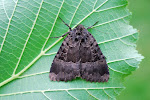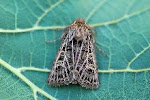Since my last post, I've caught plenty more early spring gems...
On the 23rd, along with the regular seasoning of Common Quakers, March Moths and Hebrew Characters, I caught a welcome 3
Twin-spotted Quaker. The variation between them was interesting, especially an individual which hosted 7 spots on each wing, and not the usual 2! After looking in the 'Larger Moths of Surrey' atlas, Collins describes specimens with increased spotting as rare in Surrey...
The usual form...
On the 24th, I moved the 15w actinic to the other end of the garden, with a sheet behind it to reflect the light to all areas of the garden.
It paid off and I caught 4 new species for the garden;
Small Brindled Beauty,
Small Quaker and an individual of each
Amblyptilia acanthadactyla and
Agonopterix sp.- the latter of which to me looks very promisingly like A.
scopariella- Only 6 sites appearing to be shown on the provisional micro distribution maps for Surrey. Photo send to CR for identification.
Small Brindled Beauty...
Small Quaker and Common Quaker (and to think I was previously afraid of how I would seperate the two species should I ever catch them!)...
Amblyptilia acanthadactyla
I'll post the outcome of the mystery micro, as well as a mystery Chestnut sp. that I'm also in the process of IDing, and a Clouded Drab that I haven't had to photograph, in due time... moth trapping is a busy process!











.JPG)
.JPG)


































